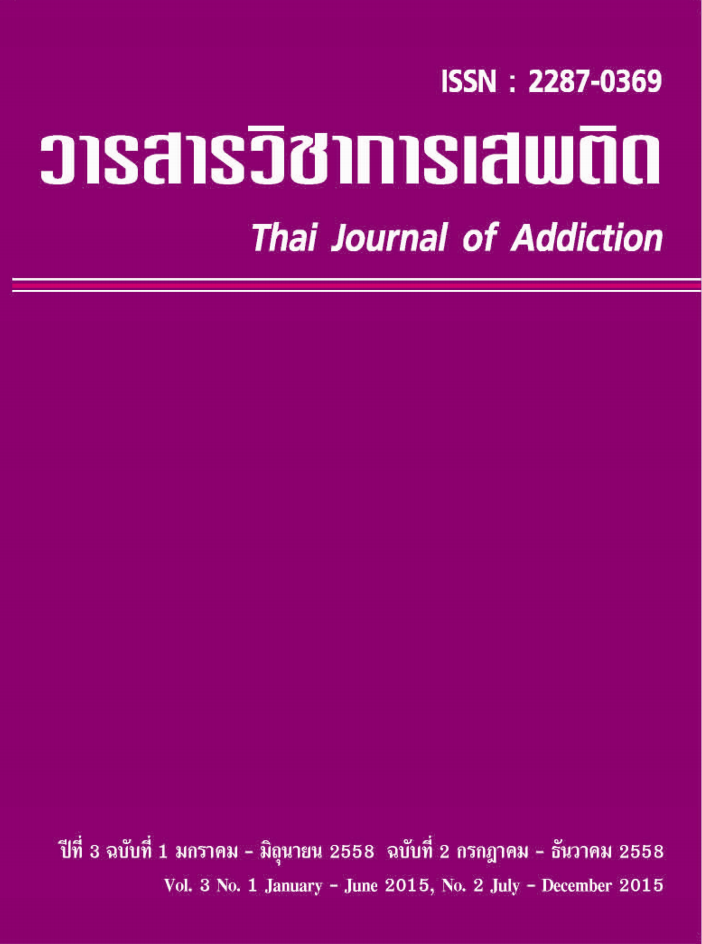A psychosocial intervention for reducing or abstaining from alcohol dependence among individuals receiving treatment in a government hospital: evidence-based nursing
Keywords:
guidelines or model of psychosocial intervention, reducing or abstinent of alcohol, individuals with alcohol dependence in inpatient departments, evidence-based nursingAbstract
This study had an objective to synthesize evidence regarding the guideline or model of psychosocial intervention for reducing or abstaining from alcohol dependence among individuals receiving treatment in hospital. The procedures involved were 1) to identify clinical issues needed to be examined 2) to search for evidence based on Population, Intervention, Comparison intervention and Outcome (PICO) 3) to conduct quality assessment and determine the reliability of the evidence and 4) to synthesize empirical evidence. After researching the related contents,
4 topics of evidence was obtained and qualified by their quality and strength. One research was Experimental study, One research was Case-control study, One research were Quasi-experimental research and One group pretest- posttest design and follow up (time series) Case-control study design.
Suggestions obtained from the evidence analysis indicated that 1) the recipients of the treatment were individuals with alcohol dependence aged 18 and above, with no psychiatric symptoms and alcohol withdrawal. Their motivation remained undecided or decided and they had received treatment in the hospital at least five days after drug withdrawal. 2) The therapists should have the knowledge and experience of group therapy and counseling of people with mental health problems from alcohol. They should be trained in therapy to change the individuals’ thoughts and behaviors and also to create motivation. 3) Group therapy promoted healing factors. 4) Therapy processes included the creation of interpersonal relationships and preparation, the creation of motivation for treatment and abstinence, learning and practicing the skills needed to promote alcohol abstinence, and prevent relapse behavior after being discharged from hospital. 5) The number of therapy sessions ranged from 4-10 times. 6) Additional therapy may be needed such as counseling for strengthening motivation to promote, long term abstinence, spouse therapy, and family therapy in an ongoing basis or outpatient therapy.
This research study proposed that a Pilot Study should be conducted in certain organizations to evaluate both the process and outcomes of therapy.
References
จินตนา ลี้จงเพิ่มพูน. ความชุกของความผิดปกติของพฤติกรรมการดื่มสุราและโรคจิตเวชร่วมใน
คนไทย: การสำรวจระบาดวิทยาระดับชาติ 2551. วารสารสุขภาพจิต แห่งประเทศไทย. 2554;
19: 88-102.
2. สุนทรี ศรีโกไสย. ประสิทธิผลของการบำบัดเพื่อเสริมสร้างแรงจูงใจในการลดปัญหาการดื่มสุรา
ของผู้ติดสุราที่รับบริการในโรงพยาบาลสวนปรุง.วารสารสภาการพยาบาล. 2548; 25: 67-79.
3. สถาบันธัญญารักษ์ กรมการแพทย์ กระทรวงสาธารณสุข. [สืบค้น 20 ธันวาคม 2557]
เข้าถึงได้จาก http://www.thanyarak.go.th/thai/index.php?option=com_content&
task=view&id =2020&Itemid=53.
4. อังกูร ภัทรากร. แนวทางการบำบัดรักษาและฟื้นฟูสมรรถภาพผู้ติดยาเสพติดรุนแรง (Hardcore). กรุงเทพฯ: สำนักงานกิจการโรงพิมพ์ องค์การสงเคราะห์ทหารผ่านศึก; 2548.
5. สถาบันธัญญารักษ์ กรมการแพทย์ กระทรวงสาธารณสุข. ตำราเวชศาสตร์การเสพติด.
กรุงเทพมหานคร: โรงพิมพ์องค์การสงเคราะห์ทหารผ่านศึก; 2544.
6. สุกุมา แสงเดือนฉาย, วิลาสลักษณ์ ชัววัลลี, อรพินทร์ ชูชม, พิชัย แสงชาญชัย. ผลของโปรแกรมการบำบัดความคิดและพฤติกรรมร่วมกับแรงสนับสนุนทางสังคมที่มีต่อการป้องกันการติดซ้ำของผู้ป่วยที่มีปัญหาการดื่มสุรา. วารสารสุขภาพจิตแห่งประเทศไทย. 2554; 19: 30-41.
7. พนาวัลย์ จ้างประเสริฐ, ปรียารัตน์ บุญสง่า. ผลการบำบัดทางจิตสังคมร่วมกับการเสริมสร้างแรงจูงใจในผู้ป่วยติดสุรา. วารสารโรงพยาบาลศรีธัญญา. 2554; 11: 2-17.
8. Suresh Kumar and Biju Thomas. Family intervention therapy in alcohol dependence syndrome: One-year follow-up study. Indian Journal Psychiatry. 2007; 49:200–204.



